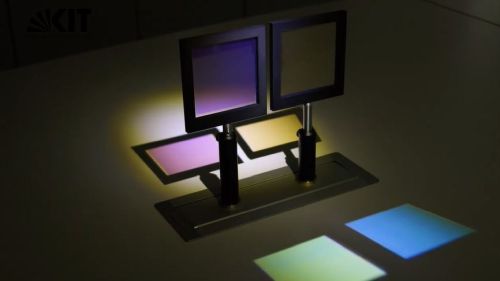Telescopes, light barriers, cameras, laser measurement technology, or smartphones: In many devices and systems, optical filters ensure that light is reflected or transmitted depending on its wavelength. Researchers at Karlsruhe Institute of Technology (KIT) have developed new materials and an innovative process technology to produce such filters with an inkjet printer. They will demonstrate the inexpensive and energy- efficient manufacturing process from April 17 to 21 at Hannover Messe 2023 (Future Hub, Hall 2, Booth B45).
Video “Optische Filter aus dem Tintenstrahldrucker – kostengünstig und anpassbar” (Inkjet Printer to Produce Optical Filters – Inexpensive and Customizable) (in German with English subtitles)
“Optical mirrors and filters are needed wherever light is involved in your work,” explains Professor Uli Lemmer, Head of the Light Technology Institute (LTI) at KIT. “Until now, however, they have been manufactured in complex vacuum systems that consume a lot of energy and material and have a comparatively low throughput.” Optical filters consist of many nanometer-thin, superimposed layers made of two different materials that have a different thickness and refractive index. Conventional production methods rely on vapor deposition of the material on large surfaces at high temperatures in large plants – an energy-hungry process during which a lot of material is lost.
Inkjet Printer to Produce Optical Filters
With their novel process, developed as part of the Cluster of Excellence called “3D Matter Made to Order” initiated by KIT and the Heidelberg University and in the course of a project of the Baden-Württemberg Foundation, Uli Lemmer and his team intend to reduce manufacturing costs and to flexibly adapt the properties of the product to the respective application. This is why the researchers use an inkjet printer to produce inkjet optical filters (IJPOFs). To do so, they use two different inks specifically developed for this process. The first ink is printed drop by drop until the layer has the desired thickness. Then, the material is cured by means of UV light. The next layer is then produced from the second ink using the same process. Thus, the inkjet printer produces an optical filter layer by layer from two materials that are applied alternately.
Custom-Fit Products for Specific Applications
“One challenge here is to precisely determine the printing and drying parameters, but above all, it is essential to vary the layer thicknesses so that we get exactly what we want,” Uli Lemmer explains. “It is indeed the layer thickness that determines the final properties of the filter.” The process developed at LTI is particularly suitable for special designs, which are usually associated with high costs due to a lack of efficient production methods for them to date. According to the researchers, the applications that have a high demand for the filters produced by inkjet printers include spectroscopic procedures in medicine, metrological devices for the chemical industry, or telescopes with a high reflectance that need to cover a large surface.
High-Performance Mirror with Ultra-High Reflectance
The LTI scientists use the novel inkjet printing process to produce not only optical filters, but also dielectric mirrors. These high-tech mirrors, also known as “Bragg mirrors,” are used in applications such as camera systems, microscopes, or sensor systems. They guide the light at the right wavelength exactly to the point where it is needed. With their printing process, also developed in the “3D Matter Made to Order” Cluster of Excellence, the researchers manage to produce “Bragg mirrors” by printing nano-particle inks on different surfaces. The filters have an ultra-high reflectance value of 99 percent and custom optical properties. The manufacturing method is suitable for optical components in the micrometer range, which are used e.g. in cameras, but also for large surfaces such as PV modules. The aim of Uli Lemmer and his doctoral researchers is to lead this innovative technology for the production of a new generation of optical filters and mirrors to commercial success by founding a spin-off company.
Video “Optische Filter aus dem Tintenstrahldrucker – kostengünstig und anpassbar” (Inkjet Printer to Produce Optical Filters – Inexpensive and Customizable) (in German with English subtitles)
In close partnership with society, KIT develops solutions for urgent challenges – from climate change, energy transition and sustainable use of natural resources to artificial intelligence, sovereignty and an aging population. As The University in the Helmholtz Association, KIT unites scientific excellence from insight to application-driven research under one roof – and is thus in a unique position to drive this transformation. As a University of Excellence, KIT offers its more than 10,000 employees and 22,800 students outstanding opportunities to shape a sustainable and resilient future. KIT – Science for Impact.


